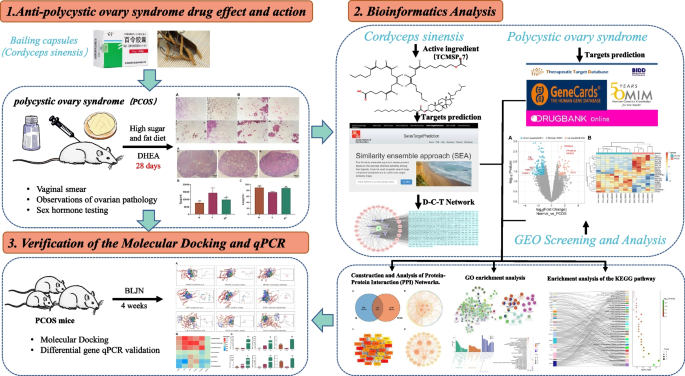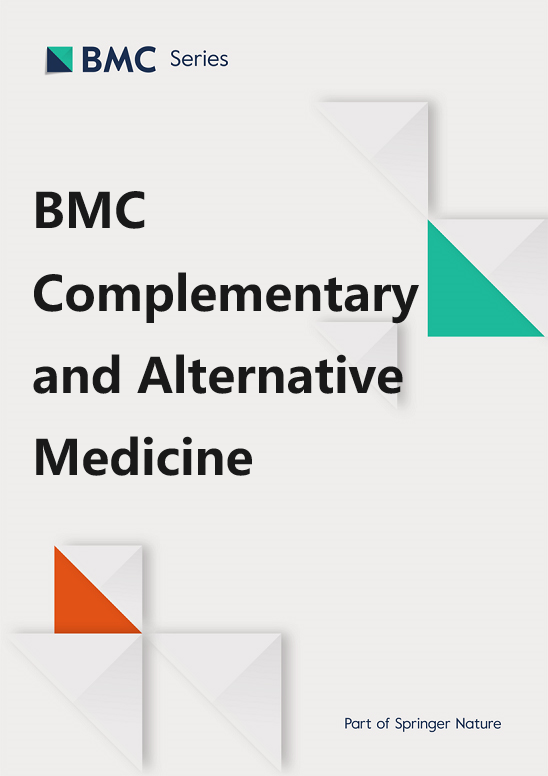Integrated bioinformatics and network pharmacology to explore the therapeutic target and molecular mechanisms of Bailing capsule on polycystic ovary syndrome
IF 3.4
2区 医学
Q1 Medicine
引用次数: 0
Abstract
Polycystic ovary syndrome (PCOS) is a complex endocrine and metabolic disorder that is common in women of reproductive age. The clinical features of PCOS include hyperandrogenemia and polycystic ovarian changes. Bailing capsule (BL), a proprietary Chinese medicine that contains fermented Cordyceps sinensis powder, has been applied to treat PCOS. However, the specific active ingredients of BL and its mechanisms of action are yet to be elucidated. Initially, the effectiveness of BL on PCOS model mice was evaluated. Subsequently, the active ingredients of BL were searched in the TCMSP and TCM Systems Pharmacology databases, and their targets were predicted using Swiss Target Prediction and SEA databases. Furthermore, the GEO gene database was used to screen for differentially expressed genes (DEGs) related to PCOS. Data from Gene Card, OMIM, DDT, and Drugbank databases were then combined to establish a PCOS disease gene library. Cross targets were imported into the STRING database to construct a protein–protein interaction network. In addition, GO and KEGG pathway enrichment analyses were performed using Metascape and DAVID databases and visualized using Cytoscape software and R 4.2.3. The core targets were docked with SYBYL-X software, and their expressions in PCOS mice were further verified using qPCR. The core active ingredients of BL were identified to be linoleyl acetate, cholesteryl palmitate, arachidonic acid, among others. Microarray data sets from four groups containing disease and normal samples were obtained from the GEO database. A total of 491 DEGs and 106 drug–disease cross genes were selected. Estrous cycle and ovarian lesions were found to be improved in PCOS model mice following BL treatment. While the levels of testosterone, progesterone, and prolactin decreased, that of estradiol increased. qPCR findings indicated that the expressions of JAK2, PPARG, PI3K, and AKT1 were upregulated, whereas those of ESR1 and IRS1 were downregulated in PCOS model mice. After the administration of BL, the expressions of associated genes were regulated. This study demonstrated that BL exerted anti-PCOS effects via PIK3CA, ESR1, AKT, PPARG, and IRS1 targets affecting PI3K-Akt signaling pathways. This research clarified the multicomponent, multitarget, and multichannel action of BL and provided a theoretical reference for further investigations on its pharmacological basis and molecular mechanisms against PCOS.

综合生物信息学和网络药理学探索百令胶囊对多囊卵巢综合征的治疗靶点和分子机制
多囊卵巢综合征(PCOS)是一种复杂的内分泌和代谢疾病,常见于育龄妇女。多囊卵巢综合征的临床特征包括高雄激素血症和多囊卵巢改变。百令胶囊(BL)是一种含有发酵冬虫夏草菌粉的中成药,已被用于治疗多囊卵巢综合征。然而,百灵胶囊的具体活性成分及其作用机制仍有待阐明。最初,研究人员评估了冬虫夏草粉对多囊卵巢综合征模型小鼠的疗效。随后,在 TCMSP 和 TCM Systems Pharmacology 数据库中检索 BL 的活性成分,并利用 Swiss Target Prediction 和 SEA 数据库预测其靶点。此外,还利用GEO基因数据库筛选与多囊卵巢综合征相关的差异表达基因(DEGs)。然后将来自 Gene Card、OMIM、DDT 和 Drugbank 数据库的数据结合起来,建立了 PCOS 疾病基因库。交叉靶标被导入 STRING 数据库,以构建蛋白质-蛋白质相互作用网络。此外,还使用 Metascape 和 DAVID 数据库进行了 GO 和 KEGG 通路富集分析,并使用 Cytoscape 软件和 R 4.2.3 进行了可视化。使用 SYBYL-X 软件对核心靶标进行了对接,并使用 qPCR 进一步验证了它们在 PCOS 小鼠中的表达。经鉴定,BL的核心活性成分为乙酸亚油酯、棕榈酸胆固醇酯、花生四烯酸等。从 GEO 数据库中获得了四组包含疾病和正常样本的微阵列数据集。共筛选出 491 个 DEGs 和 106 个药物-疾病交叉基因。经 BL 治疗后,PCOS 模型小鼠的发情周期和卵巢病变得到改善。qPCR结果显示,PCOS模型小鼠体内JAK2、PPARG、PI3K和AKT1的表达上调,而ESR1和IRS1的表达下调。服用BL后,相关基因的表达得到调节。该研究表明,BL通过影响PI3K-Akt信号通路的PIK3CA、ESR1、AKT、PPARG和IRS1靶点发挥抗多囊卵巢综合征的作用。该研究阐明了BL的多成分、多靶点和多通道作用,为进一步研究其抗多囊卵巢综合征的药理基础和分子机制提供了理论参考。
本文章由计算机程序翻译,如有差异,请以英文原文为准。
求助全文
约1分钟内获得全文
求助全文
来源期刊

BMC Complementary and Alternative Medicine
INTEGRATIVE & COMPLEMENTARY MEDICINE-
CiteScore
7.00
自引率
0.00%
发文量
0
审稿时长
3 months
期刊介绍:
BMC Complementary Medicine and Therapies is an open access journal publishing original peer-reviewed research articles on interventions and resources that complement or replace conventional therapies, with a specific emphasis on research that explores the biological mechanisms of action, as well as their efficacy, safety, costs, patterns of use and/or implementation.
 求助内容:
求助内容: 应助结果提醒方式:
应助结果提醒方式:


